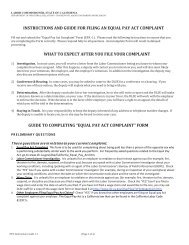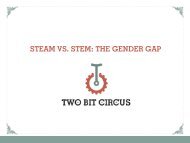EQUITY
2eGXKK2
2eGXKK2
You also want an ePaper? Increase the reach of your titles
YUMPU automatically turns print PDFs into web optimized ePapers that Google loves.
Middle-skill Jobs and Women’s Earnings<br />
Drawing on the U.S. Department of Labor’s<br />
O*Net database, this report classifies<br />
occupations into four broad skill levels: low-,<br />
middle-, higher-, and high-skill occupations.<br />
The O*Net database assesses occupations<br />
both by formal educational attainment and<br />
on-the-job training and preparation required<br />
for a worker to become competent. 8<br />
■■<br />
Middle-skill: Occupations that require<br />
at least post-secondary certification<br />
but less than a bachelor’s degree, and<br />
moderate to substantial on the jobexperience<br />
and training, including<br />
apprenticeships (for example, nursing<br />
and psychiatric aides, teachers’<br />
assistants, carpenters, or firefighters).<br />
■■<br />
Low-skill: Occupations that require a<br />
high school diploma or less, and little<br />
to moderate experience on the job (for<br />
example waiters/waitresses or security<br />
guards).<br />
■■<br />
Higher-skill: Occupations that require a<br />
bachelor’s degree, and typically some<br />
on-the-job experience (for example<br />
accountants, teachers, computer<br />
programmers).<br />
8 The O*Net database classifies occupation into five broad<br />
Job Zones; see Appendix A for a detailed description. For<br />
the purposes of this report, occupations in Job Zone 1 and<br />
Job Zone 2 that require high school only and limited on<br />
the job training are classified as low-skill. Occupations in<br />
Job Zone 2 that require high school only but considerable<br />
on-the job preparation/apprenticeships are classified<br />
as middle-skill. Occupations in Job Zone 3 that require a<br />
bachelor’s degree have been classified as higher-skill.<br />
■■<br />
High-skill: Occupations that require<br />
postgraduate or professional degrees,<br />
and typically some on the-jobexperience<br />
(for example, librarians,<br />
lawyers, and physicians).<br />
FIGURE<br />
WOMEN ARE MORE LIKELY THAN MEN TO WORK IN MIDDLE-SKILL OCCUPATIONS<br />
The Distribution of Women’s and Men’s Employment across Occupations by Broad Skill Levels, 2009–2013<br />
1.3<br />
Women<br />
40%<br />
Men<br />
43%<br />
29%<br />
33%<br />
21%<br />
20%<br />
7%<br />
7%<br />
Low-skill jobs<br />
Middle-skill jobs<br />
Higher-skill jobs<br />
High-skill jobs<br />
Notes: Employment in occupation is five year average 2009-2013.<br />
Sources: IWPR calculations based on IWPR O*Net database (see Appendix A).<br />
WWW.WOMENANDGOODJOBS.ORG PATHWAYS TO <strong>EQUITY</strong> 7




